Incredible Issues: The Incredible Hulk #4 Review
Featuring some inventive artistry, this latest Hulk issue provides a significant development for the Green Goliath
—by Nathan on November 24, 2025—
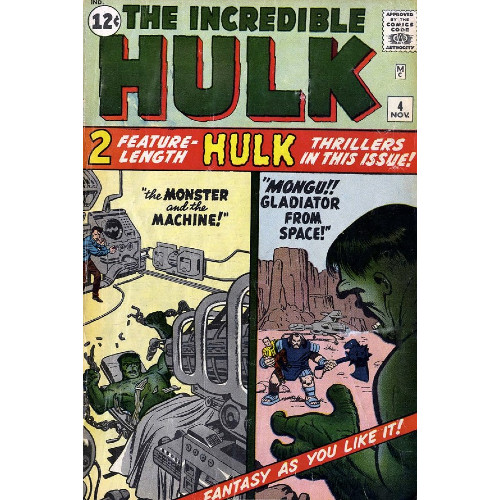
When last we left our lumbering green friend, he was actually slugging it out with Spidey over in an early Amazing Spider-Man annual, courtesy of Stan Lee, John Romita, and Don Heck. Their brawl didn't last for too long as Spidey took pity on both the childlike brute and the mild-mannered scientist he becomes once the rage wears off. Sent to capture the behemoth by the Avengers, Spidey decided it best to leave the green guy alone, though with the caveat that he could actually take the dude down if he really tried.
Maybe the story would be different if he faced a Hulk who could fly.
The last *Incredible Hulk issue I reviewed left the modern-day Goliath (no, not Hank Pym) with some bizarre developments–not only was he under the telepathic will of teenager Rick Jones, but he also utilized his tree-trunk leg muscles to propel him through the air through amazing leaps…at least, based on Lee's writing. If you look at the images, though, you could swear Jack Kirby draws the giant as if he's flying…which we'll discuss in a bit.
Rick Jones has already been through a lot these past three issues, playing babysitter to not just a walking tank but also a somewhat sappy scientist. His own character will be put to the test here as even more brand-new developments affect the life of the Hulk, one with far more staying power than turning the Hulk into an emerald comet.
"The Monster and the Machine"/"The Gladiator from Outer Space"
Writer: Stan Lee
Penciler: Jack Kirby
Inker: Dick Ayers
Colorist: Stan Goldberg
Letterer: Artie Simek
Issue: Incredible Hulk #4
Issue Publication Date: November 1962
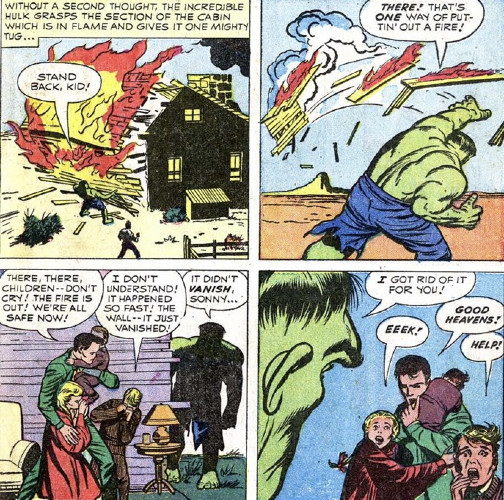
I've been somewhat harsh on these early Hulk issues, noting that it seems Lee and Kirby had very little in the way of structured, planned ideas on how to handle the character. Hero? Villain? Monster? Man? The two establish a decent duality between the brutish beast living within Bruce Banner, straining to emerge and assume control, and in Rick Jones we do find a plucky sidekick who doesn't fight by his partner's side but tries to keep his partner from fighting. Heaven knows the devastation the Hulk could cause were it not for Rick's support.
Yet what to do with this guy? You've got some recurring basic elements, but Lee and Kirby have not yet developed a "thesis statement," if you will, around who he is. There's no "dude with spider powers fights criminals at great cost to his personal life" or "quirky quartet are inspired by life-altering accident to keep humanity safe." I guess there's "genius scientist lives in fear of his bombastic alter ego," but that doesn't feel as strong a concept which would keep each issue engaging. Lee and Kirby need to put elements in place to enhance readability, which I guess is why we get the latest development in the saga of the Hulk:
His human intelligence.
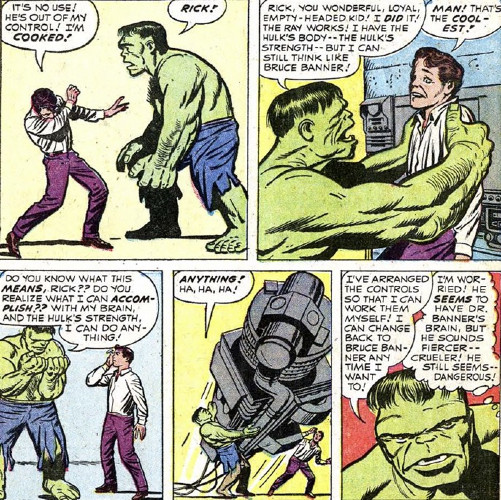
Of Lee and Kirby's concepts, it's one of the best ideas so far. Certainly better than "We say the Hulk leaps, but if you look closely, you'll notice he actually appears to be flying," which he keeps doing in this issue (you can almost hear Lee screaming at you to ignore the speed lines). Just look at those panels below. You'll believe a Hulk can fly! The idea is astronomically amusing, particularly from an artistic perspective, as it's not made terribly clear whether Lee and Kirby are on the same page (though they're working on the same pages!), similarly to how they handled this new ability in the previous issue.

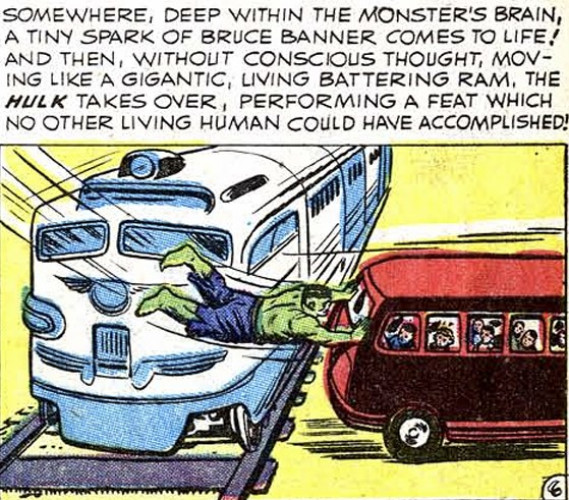
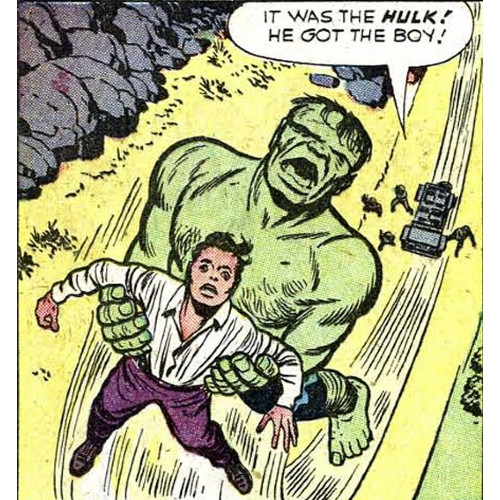
But enough about the jumping. I just think it's funny. We're more interested today in the leaps and bounds Lee and Kirby make elsewhere.
What this new "human intelligence" wrinkle in the character's development causes is an interesting synthesis between the monosyllabic monster and the human brain now piloting his body (the same experiment which unintentionally causes the mental change also removes Rick's telepathic control, leaving Banner in charge of himself again). Lee toys with the notion that, while the Hulk can speak in multi-syllable words and address Rick like an actual person instead of through grunts, Banner's takeover of his great physical form is not complete. The transfer is not perfect, and where the issue's most interesting moments occur is through Rick's analysis of his colossal charge. He sounds fiercer–crueler! Rick notes to himself. He still seems–dangerous! Something within Banner's brilliant brain is still subsumed by the Hulk's bestial rage, warping the scientist's perspective. Indeed, in the issue's second narrative, the Hulk not only physically fights several Soviet enemies but berates them verbally, choosing much more colorful, racially-tinged language than the unintelligent Hulk would use.
Cleverly, Lee seeds bits of this duality even prior to the experiment. An early scene sees the Hulk, while fleeing the military, divert himself to save a bus full of children stalled on a railroad track. Lee's narration notes that "Somewhere, deep within the monster's brain, a tiny spark of Bruce Banner comes to life!" The Hulk acts "without conscious thought," Banner's human instincts kicking in to provide these children rescue (through jumping, of course–ignore those speed lines!). The Hulk, to this point, hasn't been much of a hero, contemplating in his second issue whether to obliterate humanity! Lee uses this moment to showcase how the series' true hero is our Dr. Banner–later emphasized in a scene where he intentionally transforms into the Hulk to face a different menace–and how only through his influence can the Hulk retain any semblance of morality, even if it's just subconscious instinct.
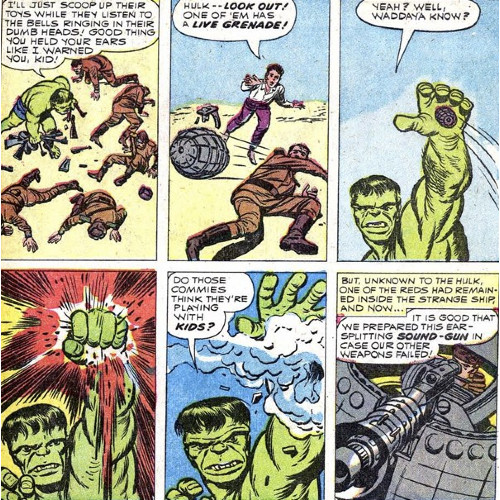
Outside these developments, a chunk of this issue seems haphazardly thrown together; Lee and Kirby have a tantalizing idea they wish to explore, but between the moments where they play with the Hulk's newfound intelligence, very little of substance happens. General Ross teases a weapon he'll end up using the next issue; the Hulk lumbers onto and disrupts a movie set (where we do, I'll note, get the first use of his patented "thunderclap") fairly randomly; characters outside Rick and Banner are fairly oddly used. Betty Ross is given a poor showing, realizing that Rick has been associated with both Bruce and the Hulk but fruitlessly considering what the larger connection might be. But her father, Thunderbolt Ross, can't piece the connection together either after she tells him, so I suppose we can cut her some slack. The characterization is just awkward, played from a certain angle because Lee needs to develop tension (no need to reveal the Hulk/Banner connection this early), but it evades logical sense. I joked about Rick being a moron for failing to put a simple two-and-two together in the last issue, but it seems he may not be only one.
Where the issue shines is through its artist, Jack Kirby. Much of the art he displays throughout the issue is interesting, but he employs a fun technique several times across both stories which enhances the reading experience. Utilizing various series of three panels across the length of a page, Kirby intentionally draws your attention to specific moments, letting time slow down and allowing the reader to soak in the drama as it unfolds before your eyes. It could be a seeming alien warrior rising from his ship, or Bruce Banner shifting back to his human form, but each elongated moments gives you pause. They break up the page from the traditional layout and focus on the quality of storytelling, the unfolding process of a moment, letting time unwind and making the issue feel as if it develops naturally instead of rushing from scene to scene. It's a very appreciated tactic.
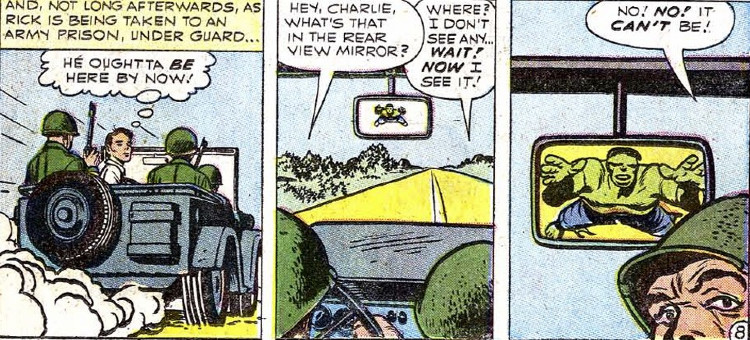
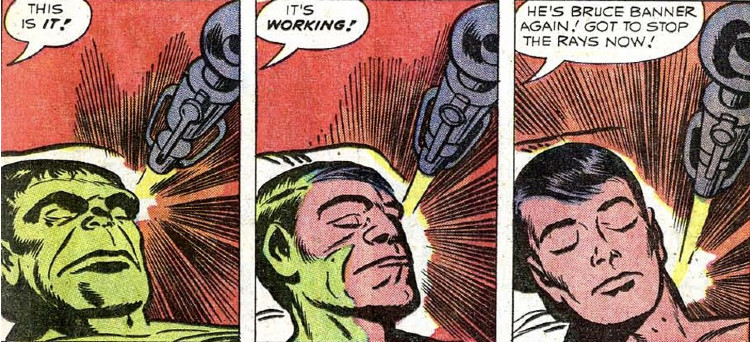


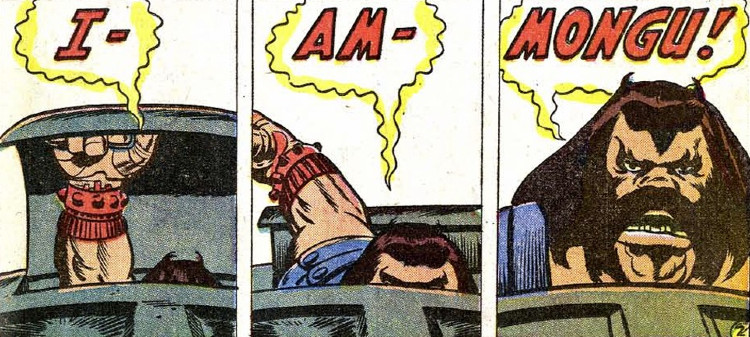
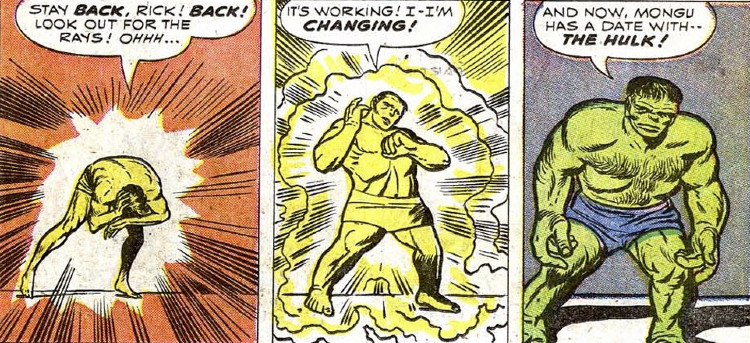
In a piece of fan mail reprinted in this issue, a reader from New York makes a suggestion to the Marvel bullpen: "But how about making the HULK a good guy, huh?" I wonder how said reader felt about this issue, which steers our musclebound man-monster in a somewhat more heroic direction. He saves kids, rescues a family from a burning building, and fights Soviet soldiers. That's a step–or even a leap–in the right direction. Of course, this reader also recommends they "get rid of that stupid kid" Rick because "[i]t was that kid's fault he became the HULK in the first place!" Such a statement provides a gross misreading of Rick Jones and his staunch sense of responsibility towards Bruce. So not every opinion voiced here is a winner. Still, the series had its fans from the jump (pun intended), and this issue certainly does what it can to support one letter writer's assertion that The Incredible Hulk "has depth, adventure, suspense, and challenges the reader's imagination."